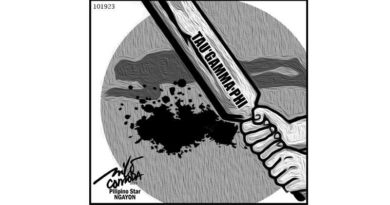PDI: Puzzling show of defeatism
Glance at a map and see if you aren’t startled at how close Panatag Shoal is to the Philippines—and why there is a so-called dispute about its ownership in the first place. The triangle-shaped outcropping of rocks and reefs, also known as Bajo de Masinloc or Scarborough Shoal to generations of Filipino fishermen, is merely 220 kilometers (124 nautical miles) from Palauig, Zambales—the nearest landmass to it. That distance is about the same as from Manila to Daet, Camarines Norte. By contrast, the nearest Chinese port, in Hainan Island, is a whopping 550 nautical miles away.
The 3-century-old map Carta Hydrographica y Chorographica de las Yslas Filipinas—drawn by the Jesuit priest Pedro Murillo Velarde, published in 1734 and obtained by Filipino businessman Mel Velarde from a Sotheby’s auction in London—definitively shows Panatag Shoal as part of Philippine territory. The map formed part of the supporting documents the Philippines submitted to the Permanent Court of Arbitration in The Hague that heard the country’s protest against China’s claim on the territory. The tribunal decided in favor of the Philippines last year, saying that China’s supposed historic claim on almost the entire South China Sea by virtue of a “nine-dash line,” which would include ownership of Panatag, the Spratly Islands and other coral reefs and atolls in the region, is without legal basis.
Unfortunately, despite the ruling China has continued to exercise effective control over Panatag since at least 2012. Previous to that, the Philippines exercised occupation and jurisdiction over the area, even putting up a lighthouse there in 1965. But China wrested it from Philippine hands basically by trickery, when it broke an agreement to jointly withdraw from the area until the ownership row is settled.
The Philippines complied but China stayed, erected a barrier to the shoal, began policing the area, and, in 2015, even used water cannons on Filipino fishermen attempting to fish in what had been their traditional fishing grounds. The fishermen were able to return only in October last year, after President Duterte went on a state visit to
China and, in effect, got that country’s permission for his countrymen to fish in the area. Suddenly, the Chinese Coast Guard wasn’t intercepting Filipino boats anymore; it had clearly gotten the memo.
Now comes the disturbing news that China is building radar facilities on Panatag. Supreme Court Associate Justice Antonio Carpio says such a station would further militarize the area: It would enable China to impose missile-supported air control over the South China Sea, and to eventually require any aircraft to seek permission from it to fly over the area. The fact is that China has already built military installations on other disputed atolls such as Mischief Reef, Subi Reef and Fiery Cross Reef. The grand plan, it appears, is to impose the discredited “nine-dash line” by sheer muscle.
Dishearteningly, President Duterte’s response to this latest provocation has been a puzzling display of defeatism: “Wala tayong magagawa dyan (There’s nothing we can do),” he said. “What do you want me to do? Declare war against China?”
Let’s make it clear: No one is advocating a war to solve this row. But, for a start, how about mobilizing the consensus of Asean, a number of whose members are also disputing China’s claims in the region? The Philippines holds the Asean chairmanship this year; can’t this administration put this urgent matter on the table? How about mobilizing the tools and opportunities of international diplomacy to pressure China to ease up on its expansionism?
How about, as Carpio says, desisting from issuing any suggestion that the Philippines is yielding its claim on parts of the South China Sea? How about exploring every other peaceful but determined option available to a sovereign nation whose territory is being gobbled up, and not behaving as though one couldn’t care less, or worse, as though one were a loser?














